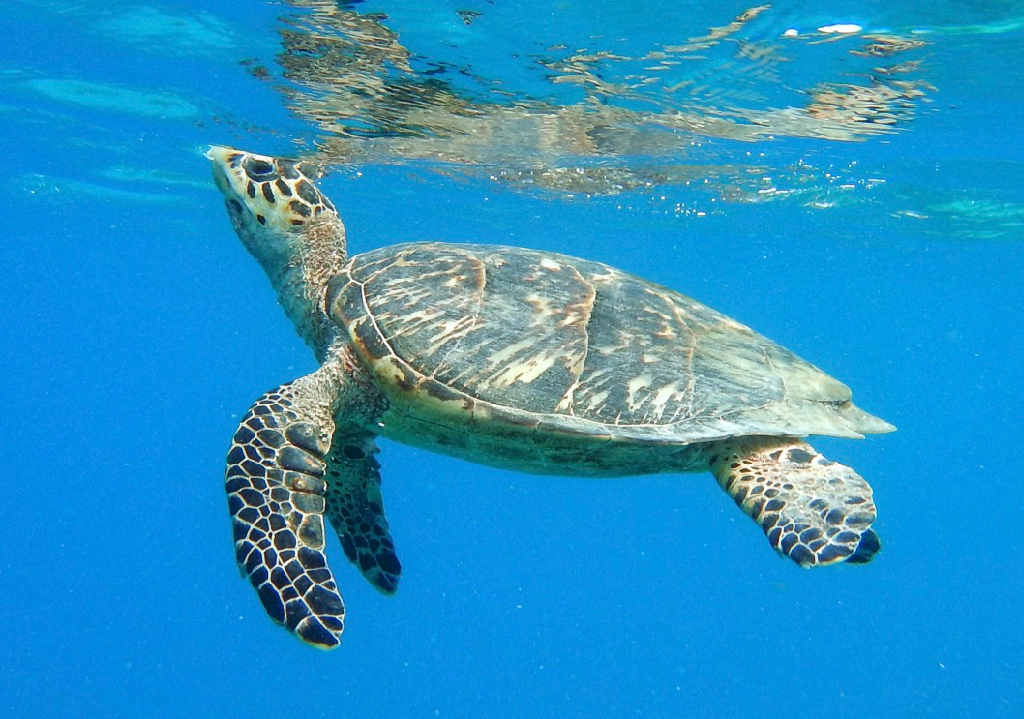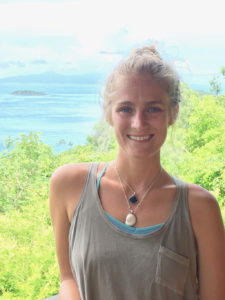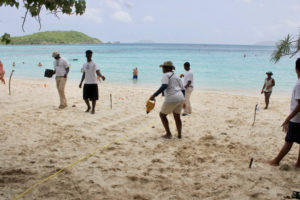

If you ever walk down a sandy beach and see what appear to be tire tracks between the vegetation line and the sea – but you don’t see a road where a vehicle could have gained access to the beach – you’ve likely spotted something rare: the tracks of a nesting hawksbill sea turtle.
Hawksbill turtles can nest any time throughout the year, but the peak season extends from June through November, according to Adren Anderson, the Sea Turtle Program coordinator for Friends of the Virgin Islands National Park. The program has been funded through the entire nesting season.
More than 40 children and adults have signed up to walk the sandy beaches of St. John in the early morning to look for signs of turtle nesting and hatching events. They’ve found four nests so far.
Hawksbill turtles are one of three species that inhabit the waters of the Virgin Islands, and the only species that is known to regularly nest on St. John. Green turtles, which are commonly seen, feed in the area but have been known to nest on St. John only once.
There have been several recorded hatchings of leatherback turtles on St. John in the past, but these creatures, which can weigh as much as 1,000 pounds, prefer the long, sandy expanse of the beach at Sandy Point on the West End of St. Croix.
“A lot of our beaches on St. John are bordered by shallow coral reefs. Leatherbacks are huge; they need deeper approaches,” said Anderson. “I know they used to nest here regularly – that’s how Trunk Bay got its name.”
Hawksbill turtles, which can weigh as much as 170 pounds, have been prized by hunters for their beautiful shells and are classified as critically endangered. They have not traditionally been hunted for food in the Virgin Islands, perhaps because of their diet. They feed on sponges, which contain substances toxic to humans that accumulate in the turtles’ bodies.
Sea turtle eggs, however, were thought to enhance sexual prowess, and local bakers have told Anderson, “They make the best cakes.” Dogs and mongooses also feed on turtle eggs, and to protect nests, Anderson and her volunteers are patrolling the beaches on a regular basis.

Female hawksbill turtles, which begin laying eggs at around age 30, will typically lay between one and seven nests per season, with up to two-week intervals between nesting events. At night, they crawl up on a beach, often to the vegetation line, and dig a hole using their hind flippers, which are equipped with a claw that can cut through roots and branches.
The nesting females dig a lightbulb-shaped hole into which they deposit between 100 and 200 eggs, then cover it with sand and retreat to the sea. Between 55 and 75 days later, the new hatchlings will emerge from the nest and crawl into the sea, usually under the cover of darkness. The odds of survival are slim. Marine biologists think only one out of 1,000 reach breeding age.
Anderson has been training volunteers to detect signs of new nests and recent hatchings, such as indentations where nests were laid and track marks left by the turtles’ flippers. Once an active nest has been found, Anderson covers it with a metal screen to protect it from depredation by dogs and mongooses. The screen has holes large enough for new hatchlings to crawl through.
No one knows what the lifespan is for hawksbill turtles.
“There are a lot of numbers out there” said Anderson. “It’s around 80 years, but there’s not a great way to age them unless you start tracking them as hatchlings.”
Anderson has worked on projects monitoring loggerhead turtles in Georgia and Antigua. She said studies of maternal DNA in the shells of loggerheads have revealed that up to three generations nest at the same beaches during the same season.
Volunteers for the project on St. John sign up to patrol beaches in the early morning to observe any nesting or hatching events before human activity or rain showers obscure the signs. Most volunteers monitor beaches near their homes, where they’d be likely to walk anyway, Anderson said, but some agree to hike several miles to patrol more remote beaches.
When she is not working with volunteers, Anderson visits camps and schools to educate children about the turtle monitoring program and the importance of protecting the marine environment.
Further information is available by contacting Anderson at adrenand@gmail.com.
Shared content for Virgin Islands Source and St. John Tradewinds.





